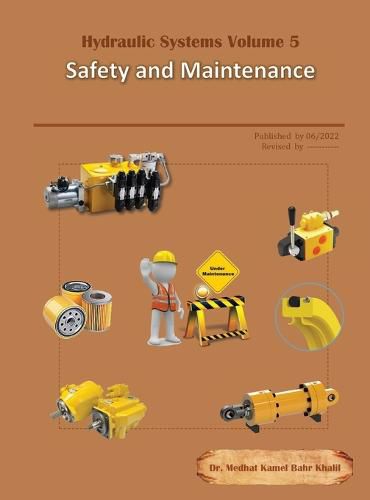Readings Newsletter
Become a Readings Member to make your shopping experience even easier.
Sign in or sign up for free!
You’re not far away from qualifying for FREE standard shipping within Australia
You’ve qualified for FREE standard shipping within Australia
The cart is loading…






This title is printed to order. This book may have been self-published. If so, we cannot guarantee the quality of the content. In the main most books will have gone through the editing process however some may not. We therefore suggest that you be aware of this before ordering this book. If in doubt check either the author or publisher’s details as we are unable to accept any returns unless they are faulty. Please contact us if you have any questions.
Safety and maintenance are very important experience to whoever involved in designing, commissioning, operating, and servicing hydraulic systems. Gaining such experience help to avoid future unexpected shutdowns, hence improve system reliability and safety of work environment. This book introduces the concept and best practices of hydraulic components and system maintenance. This book is targeting industry professionals who are in charge of operating, maintaining, and troubleshooting hydraulic systems. This book is also a great resource for mechanical engineers and service manuals technical writers. The books start by introducing best practices for safe design, commissioning, operating and servicing hydraulic components. The book then presents the maintenance concepts and measuring instruments commonly applicable for hydraulic system maintenance. The book follows that by presenting five sets of best practices for each of the following components: pumps, motors, cylinders valves, accumulators, reservoirs, transmission lines, heat exchangers, and filters. It is to be noted that, the listed best practices and maintenance actions are based on the author's experience and may not be applicable in each case. Therefore, the author is highly recommending reviewing the instructions from component and system manufacturers as considered the main and first source of information. This book is colored and has the size of standard A4. The book contains a total of twelve chapters distributed over 350 pages with very demonstrative figures and tables. The contents of the book are brand non-biased and intends to introduce the latest technologies related to the subject of the book. The book is the fifth in a series that the author plans to publish to offer a complete and comprehensive teaching curriculum for fluid power industry. The book is associated with a separate colored workbook. The workbook contains printed power point slides, chapter reviews and assignments. The book presents five sets of best practices for each of the following components: pumps, motors, cylinders valves, accumulators, reservoirs, transmission lines, heat exchangers, and filters. The five sets of best practices are as follows: ? BP-X Components-01-Selection and Replacement
? BP-X Components-02-Maintenance Scheduling
? BP-X Components-03-Installation and Maintenance Practices
? BP-X Components-04-Standard Tests and Calibration
? BP-X Components-05-Transportation and Storage
$9.00 standard shipping within Australia
FREE standard shipping within Australia for orders over $100.00
Express & International shipping calculated at checkout
This title is printed to order. This book may have been self-published. If so, we cannot guarantee the quality of the content. In the main most books will have gone through the editing process however some may not. We therefore suggest that you be aware of this before ordering this book. If in doubt check either the author or publisher’s details as we are unable to accept any returns unless they are faulty. Please contact us if you have any questions.
Safety and maintenance are very important experience to whoever involved in designing, commissioning, operating, and servicing hydraulic systems. Gaining such experience help to avoid future unexpected shutdowns, hence improve system reliability and safety of work environment. This book introduces the concept and best practices of hydraulic components and system maintenance. This book is targeting industry professionals who are in charge of operating, maintaining, and troubleshooting hydraulic systems. This book is also a great resource for mechanical engineers and service manuals technical writers. The books start by introducing best practices for safe design, commissioning, operating and servicing hydraulic components. The book then presents the maintenance concepts and measuring instruments commonly applicable for hydraulic system maintenance. The book follows that by presenting five sets of best practices for each of the following components: pumps, motors, cylinders valves, accumulators, reservoirs, transmission lines, heat exchangers, and filters. It is to be noted that, the listed best practices and maintenance actions are based on the author's experience and may not be applicable in each case. Therefore, the author is highly recommending reviewing the instructions from component and system manufacturers as considered the main and first source of information. This book is colored and has the size of standard A4. The book contains a total of twelve chapters distributed over 350 pages with very demonstrative figures and tables. The contents of the book are brand non-biased and intends to introduce the latest technologies related to the subject of the book. The book is the fifth in a series that the author plans to publish to offer a complete and comprehensive teaching curriculum for fluid power industry. The book is associated with a separate colored workbook. The workbook contains printed power point slides, chapter reviews and assignments. The book presents five sets of best practices for each of the following components: pumps, motors, cylinders valves, accumulators, reservoirs, transmission lines, heat exchangers, and filters. The five sets of best practices are as follows: ? BP-X Components-01-Selection and Replacement
? BP-X Components-02-Maintenance Scheduling
? BP-X Components-03-Installation and Maintenance Practices
? BP-X Components-04-Standard Tests and Calibration
? BP-X Components-05-Transportation and Storage